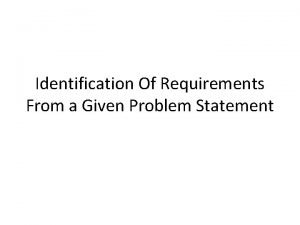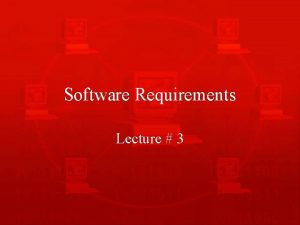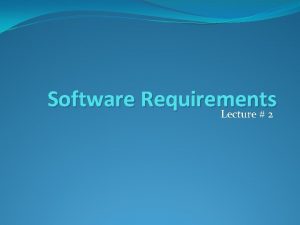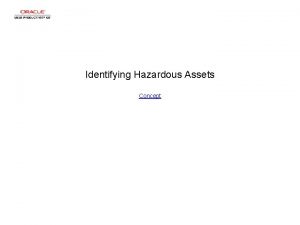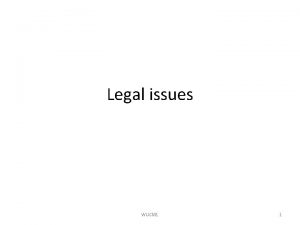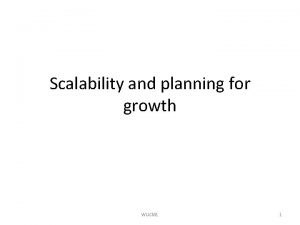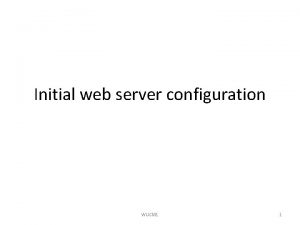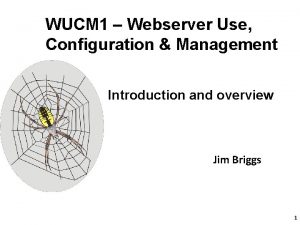Identifying requirements WUCM 1 1 Requirements engineering Requirements











- Slides: 11

Identifying requirements WUCM 1 1

Requirements engineering • Requirements elicitation – Consult with stakeholders – View system documents – Use domain knowledge – Undertake market studies • Requirements negotiation – Formal process with stakeholders – Decide on which to accept • Requirements validation • Requirements analysis – Check for consistency – Check for completeness – Tease out the detail WUCM 1 2

Types of requirement • General requirements – which set out in broad terms what the system should do. • Functional requirements – which define part of the system’s functionality. • Non-functional requirements – set out the tolerances, boundaries and standards needed to deliver the functions WUCM 1 3

Non-functional requirements • Performance requirements – specify a minimum acceptable performance for the system • Availability requirements – significant in a web system with global access. Reliability? MTBF? Etc. • Security requirements – specify who can and cannot do what • Implementation requirements – state how the system must be implemented • Scalability requirements – what future growth in demand should be catered for • Usability requirements – specify the usability in a measurable way WUCM 1 4

Reasons for a website • Four broad reasons: – To inform or educate – To entertain – To market, sell or persuade – To stroke someone’s ego –… • Most websites serve more than one purpose • Most are designed to make money (directly or indirectly) WUCM 1 5

Examples • To inform or educate – – – – • To market, sell or persuade Universities, schools, colleges Charitable foundations Non-profit organisations Government Business Political organisations … – – – Businesses Political organisations Non-profit organisations Universities, schools, colleges Religious organisations • To stroke someone’s ego • To entertain – Galleries and museums. – Magazines, E-Zines etc. – Media organisations WUCM 1 – – – Personal home pages Opinion sites Fanzines and fan clubs Personal resumes/CVs … 6

Roles • Owners • Stakeholders • Audience • Developers • Content providers • Managers WUCM 1 7

Who is your audience? • Why is your information needed? Solve a problem? Make someone feel good? Get them involved? Tell them something new? Sell them something? Teach them a new way to do something? – … – – – • What do you want the user to do? – – – – – WUCM 1 E-mail you? Fill out an order form? Phone you? Complete a survey or application form? Write a letter to someone? Vote? Join a mailing list? Come back on a regular basis? … 8

Why know your audience? • Knowing your audience will colour many of your requirements – The non-functional ‘artistic’ website type requirements – The more technical server requirements – What balance of the two is needed? WUCM 1 9

Content requirements issues • Volume of data • ‘Churn’ of data – Significant impact on both hardware and software – It is important to get an estimate for: • • – Measure of the proportion of the total web space changed per unit of time, e. g. hour, week – Need to back track through older versions of documents? number of files average size of files database size total size of the web space • Number of ‘hits’ – Estimates will feed the capacity questions – Estimate the rate of growth of data to be served: feeds the scalability requirement WUCM 1 – For a new site: based on hope and expectation – For an existing site: collect data and consciously feed it into ongoing management is vital 10

Requirements should (ideally) be: • Well-defined • Measurable and testable – Clear and unambiguous so that it is possible to derive a design from it that can gain the customer’s acceptance on it being fulfilled • Achievable – Doable using ordinary means unless extraordinary means are part of the requirements WUCM 1 – Needs to be a way of determining whether the requirement has been fulfilled, especially if your fee is contingent on acceptance! 11
 Adjective
Adjective Whats an adjective clause
Whats an adjective clause Identifying and non identifying adjective clauses
Identifying and non identifying adjective clauses System functional requirements
System functional requirements What is system design in software engineering
What is system design in software engineering Forward engineering in software engineering
Forward engineering in software engineering Engineering elegant systems: theory of systems engineering
Engineering elegant systems: theory of systems engineering Engineering elegant systems: theory of systems engineering
Engineering elegant systems: theory of systems engineering Forward and reverse engineering
Forward and reverse engineering Engineering requirements document
Engineering requirements document Domain requirements
Domain requirements Inverse requirements example
Inverse requirements example



